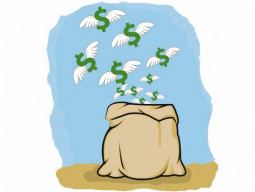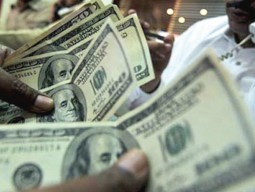
The State Bank of Pakistan has purchased $250 million to meet the target of Net International Reserves (NIR) set by the International Monetary Fund (IMF). However, the rupee has still gained against the US dollar, giving rise to speculation of a tacit understanding between foreign exchange companies and the authorities to stem the tide of a falling rupee.
The purchases were made from undisclosed vendors, said sources in the Ministry of Finance. Analysts and money market experts claimed that the SBP purchased the dollars from foreign exchange companies which were bringing dollars from abroad to sell to the authorities.
Two major market players, who control two-third of the foreign exchange market, are providing dollars to the central bank, sources said. They are earning Rs2 per dollar over and above the market rate, they added.
In August this year, the SBP had also purchased $125 million from the market, which led to the depreciation of rupee against the dollar. At that time, the official foreign currency reserves had been at $5.3 billion. Now when the official foreign currency reserves stood at $2.9 billion and the SBP purchased $250 million, the rupee appreciated against the dollar, both in the interbank and open market, which was against the market dynamics, according to a former official of the SBP.
While the Ministry of Finance admitted that the SBP purchased dollars, the central bank showed its ignorance, underscoring that one of them was trying to hide facts.
“The SBP was unaware of such purchases”, said Umar Siddique, the chief spokesman for the central bank in his written response. To a question regarding an understanding with foreign exchange companies, Siddique said the SBP did not have any arrangement with foreign exchange companies.
Siddique said that since the start of December, the market has seen decent inflows that mitigated the prevailing speculative sentiments in the market, and translated into appreciation of the rupee.
While there is an abnormality in the exchange market as open market rates are unusually lower than the interbank rate, it has helped stem the rupee’s slide, which will also contribute in arresting imported inflation, according to analysts. The strengthening rupee will slow down the increase in prices of petroleum products and electricity.
In the interbank market, the rupee appreciated by about Rs2 in a matter of days, and parity was restored to Rs107.03 to a dollar on Tuesday. In the open market, the rate was Rs106.75 to a dollar.
Despite availing $6.7 billion from the IMF assistance programme, Pakistan has been struggling to shore up official foreign currency reserves that plunged to a 12-year low level of $2.9 billion on December 6. The country was also trying to achieve the NIR target for the second quarter of the fiscal year (October-December) after it missed the same target set for the first quarter.
The IMF has asked Pakistan to ensure that its net international reserves remained at a negative $2.1 billion by end December. The IMF calculates net reserves by excluding its outstanding liabilities towards Pakistan and the liabilities on account of forward contracts from the state’s currency reserves. After paying back $6.1 billion, Pakistan still owes $2.3 billion. In addition, about $2.2 billion are on account of forward contracts.
The IMF’s Executive Board will meet in Washington on Thursday to consider the approval of a second tranche of $545 million for Pakistan.
Finance Minister Ishaq Dar said last week that the country’s official reserves have increased to $3.4 billion after a $500 million injection. However, he did not disclose the source of the funds. Dar also said that the rupee-dollar exchange rate will return to Rs98 to a dollar.
When approached, the Ministry of Finance said that the $500 million inflow was made up of a $137 million short-term loan from the Islamic Development Bank, SBP’s purchases of dollars from the market and realisation of exports receipts.
The ministry strongly refuted allegations that there was tacit understanding between the authorities and main players of the foreign exchange market, but it could not justify the appreciation of the rupee despite SBP’s purchase of dollars and shortages of the foreign currency except by saying that hoarders have bought dollars in the market.
Published in The Express Tribune, December 18th, 2013.
Like Business on Facebook, follow @TribuneBiz on Twitter to stay informed and join in the conversation.
COMMENTS (3)
Comments are moderated and generally will be posted if they are on-topic and not abusive.
For more information, please see our Comments FAQ































1714024018-0/ModiLara-(1)1714024018-0-270x192.webp)









Are they running a country or a soup kitchen in a private home?
You can only manipulate currency market so much - just makes the inevitable drop that much bigger.
Calm before the storm